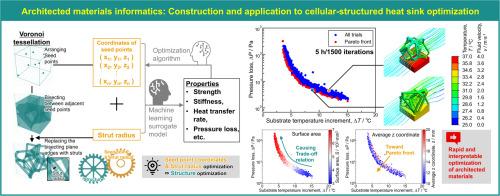当前位置:
X-MOL 学术
›
Acta Mater.
›
论文详情
Our official English website, www.x-mol.net, welcomes your
feedback! (Note: you will need to create a separate account there.)
Architected materials informatics: Construction and application to cellular-structured heat sink optimization
Acta Materialia ( IF 8.3 ) Pub Date : 2024-11-10 , DOI: 10.1016/j.actamat.2024.120557 Asuka Suzuki, Hideto Nakatani, Soya Nakagawa, Makoto Kobashi, Yoshiyuki Tsuji
Acta Materialia ( IF 8.3 ) Pub Date : 2024-11-10 , DOI: 10.1016/j.actamat.2024.120557 Asuka Suzuki, Hideto Nakatani, Soya Nakagawa, Makoto Kobashi, Yoshiyuki Tsuji

|
Additive manufacturing permits intentionally controlling the geometry of architected materials to achieve desired properties. It is important to design and optimize the geometry of architected materials within a wide search space. This study integrates Voronoi tessellation and informatics to construct architected materials informatics for geometry optimization. Voronoi tessellation can design diverse architected materials by dividing a design space with bisecting planes between arbitrarily arranged seed points and replacing the bisecting plane edges with solid struts. The neural network surrogate model predicts the properties of the architected materials based on the seed point coordinates and the strut radius. The genetic algorithm inversely analyzes the surrogate model to optimize the seed point coordinates and strut radius directly linked to the optimized architected material geometry. This framework rapidly optimized the geometry of cellular-structured heat sinks, optimally balancing pressure loss and heat transfer (Pareto front) under forced convection. The optimized geometry of the Pareto front was validated using computational fluid dynamics and experiments. In addition, the data obtained during the optimization was analyzed to develop a strategy to improve the pressure loss and heat transfer trade-off. This study provides architected materials informatics framework to optimize the geometry of architected materials for diverse applications.
中文翻译:

建筑材料信息学:蜂窝结构散热器优化的构建及应用
增材制造允许有意识地控制建筑材料的几何形状以实现所需的特性。在广泛的搜索空间中设计和优化建筑材料的几何图形非常重要。本研究将 Voronoi 镶嵌和信息学相结合,构建用于几何优化的建筑材料信息学。Voronoi 镶嵌可以通过在任意排列的种子点之间划分具有平分平面的设计空间,并用实心支柱替换平分平面边缘来设计不同的建筑材料。神经网络代理模型根据种子点坐标和支柱半径预测架构材料的属性。遗传算法对代理模型进行逆向分析,以优化与优化的架构材料几何形状直接相关的种子点坐标和支柱半径。该框架快速优化了蜂窝结构散热器的几何形状,在强制对流下实现了压力损失和传热(帕累托前沿)的最佳平衡。使用计算流体动力学和实验验证了帕累托前沿的优化几何形状。此外,还分析了优化期间获得的数据,以制定一种策略来改善压力损失和传热权衡。本研究提供了 Architected Materials 信息学框架,以优化 Architected Materials 的几何结构,以用于各种应用。
更新日期:2024-11-10
中文翻译:

建筑材料信息学:蜂窝结构散热器优化的构建及应用
增材制造允许有意识地控制建筑材料的几何形状以实现所需的特性。在广泛的搜索空间中设计和优化建筑材料的几何图形非常重要。本研究将 Voronoi 镶嵌和信息学相结合,构建用于几何优化的建筑材料信息学。Voronoi 镶嵌可以通过在任意排列的种子点之间划分具有平分平面的设计空间,并用实心支柱替换平分平面边缘来设计不同的建筑材料。神经网络代理模型根据种子点坐标和支柱半径预测架构材料的属性。遗传算法对代理模型进行逆向分析,以优化与优化的架构材料几何形状直接相关的种子点坐标和支柱半径。该框架快速优化了蜂窝结构散热器的几何形状,在强制对流下实现了压力损失和传热(帕累托前沿)的最佳平衡。使用计算流体动力学和实验验证了帕累托前沿的优化几何形状。此外,还分析了优化期间获得的数据,以制定一种策略来改善压力损失和传热权衡。本研究提供了 Architected Materials 信息学框架,以优化 Architected Materials 的几何结构,以用于各种应用。


















































 京公网安备 11010802027423号
京公网安备 11010802027423号